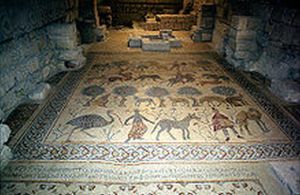“Why did they disappear as suddenly as they appeared in history? These are all tantalizing, mystifying issues.”
 Kiryat Malachi, September 30 – Archaeologists studying a newly discovered mosaic in this southern town expressed satisfaction at the level of detail preserved in the find this week, noting that the work evidently shows that people, animals, and plants of various kinds in the post-Second-Temple Period were composed of ceramic squares held together with a cement-like mortar.
Kiryat Malachi, September 30 – Archaeologists studying a newly discovered mosaic in this southern town expressed satisfaction at the level of detail preserved in the find this week, noting that the work evidently shows that people, animals, and plants of various kinds in the post-Second-Temple Period were composed of ceramic squares held together with a cement-like mortar.
A team of researchers from Tel Aviv University uncovered the mosaic as part of preliminary surveys for the construction of a new housing project. What appears to be an ancient church occupied the site between approximately 400 and 500 CE, when Israel was part of the Byzantine, or eastern Roman, Empire. The images depict humans, fish, livestock, and produce, in a manner suggesting that, unlike the modern versions of those creatures, in ancient times people and their possessions were nearly two-dimensional beings with rough outlines born of the right-angle polygons they comprised.
The archaeologists have yet to determine whether those tile-people, as they are being called, were merely a local phenomenon, or whether they were a prominent component of human society throughout the ancient Near East. Preliminary evidence indicates that other mosaics in the region depict similar creatures, which evidently disappeared from the landscape sometime after the Islamic conquest of the Levant in the seventh and eighth centuries CE. Similarly, these creatures and varieties of produce apparently did not exist until the arrival of Hellenistic culture in the region in the fourth century BCE, if the mosaics are a reliable guide.
If the phenomena were restricted to ancient Israel, as one school of thought claims, then their appearance in mosaics elsewhere in the Mediterranean region is simply evidence that peoples outside Israel were exposed to the two-dimensional, proto-cubist creatures and reproduced the imagery elsewhere. However, others maintain that tile-beings must have originated elsewhere in the Eastern Mediterranean region, given the appearance of their images in mosaics that predate the finds in Israel, many of them by several centuries.
Tuda Menschenel of Tel Aviv University explained that whichever side of that debate a scholar chooses, there remain important questions regarding the origins and fate of the tile-people. “Did they interbreed with the rest of humanity?” he asked. “Were they exterminated, or absorbed into the rest of the population? Why did they disappear as suddenly as they appeared in history? These are all tantalizing, mystifying issues.”
Menschenel added that anatomical questions alone could fill a thick volume. “Is it possible that the words that appear in the air around these figures represent the way they actually communicated, because they clearly did not have the vocal chord structure that we do? There are many, many unresolved mysteries here.”
Please support our work through Patreon.
Buy In The Biblical Sense: https://www.amazon.com/dp/B0B92QYWSL




